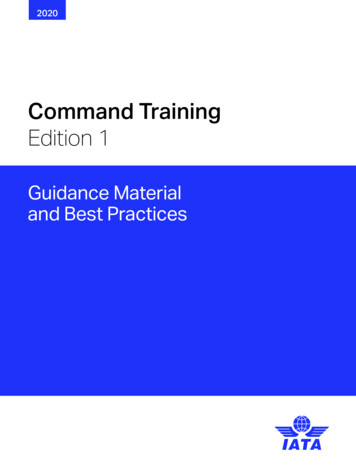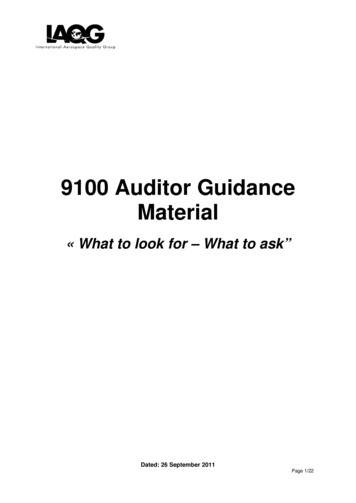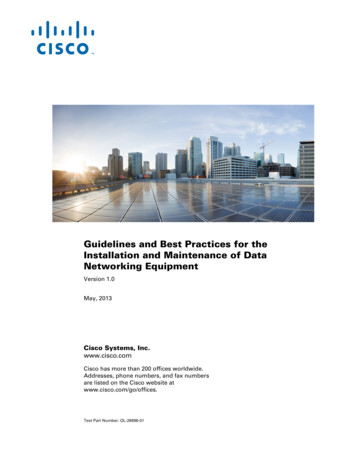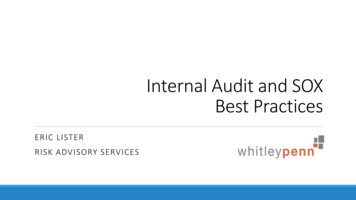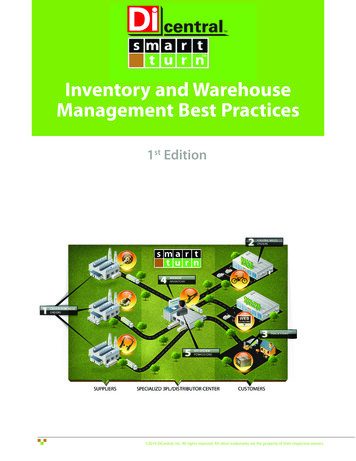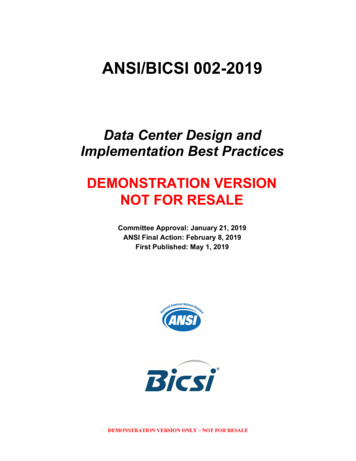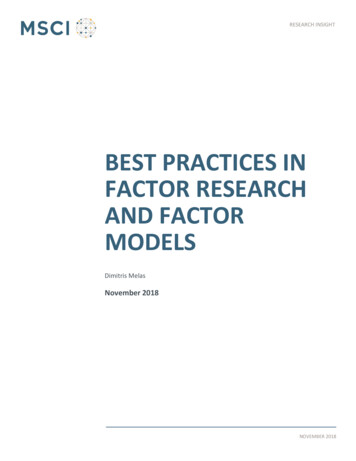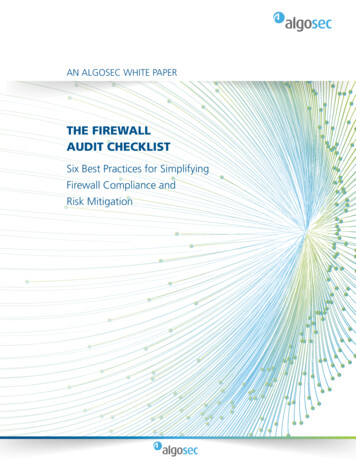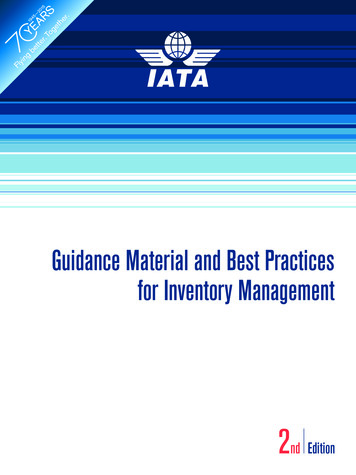
Transcription
Guidance Material and Best Practicesfor Inventory Management2nd Edition
NOTICEDISCLAIMER. The information contained in thispublication is subject to constant review in the lightof changing government requirements and regulations. No subscriber or other reader should act onthe basis of any such information without referringto applicable laws and regulations and/or withouttaking appropriate professional advice. Althoughevery effort has been made to ensure accuracy, theInternational Air Transport Association shall not beheld responsible for any loss or damage caused byerrors, omissions, misprints or misinterpretation ofthe contents hereof. Furthermore, the InternationalAir Transport Association expressly disclaims anyand all liability to any person or entity, whether apurchaser of this publication or not, in respect ofanything done or omitted, and the consequencesof anything done or omitted, by any such person orentity in reliance on the contents of this publication. International Air Transport Association. AllRights Reserved. No part of this publication maybe reproduced, recast, reformatted or transmitted in any form by any means, electronic ormechanical, including photocopying, recording or any information storage and retrieval system, without the prior written permission from:Senior Vice PresidentSafety and Flight OperationsInternational Air Transport Association800 Place VictoriaP.O. Box 113Montreal, QuebecCANADA H4Z 1M1Guidance Material and Best Practices for Inventory ManagementISBN 978-92-9252-741-9 2015 International Air Transport Association. All rights reserved.Montreal—Geneva
Table of ContentList of Figures .vList of Tables .viiAbbreviations .viiiIntroduction .xPurpose of the Guide .xiScope . xiAudience . xiObjective . xiiSection 1—Goals of Inventory Management .1Section 2—Introduction to Inventory Classification .42.1Rotable Inventory .82.2Repairable Inventory .92.3Expendable Inventory .102.4Recoverable Inventory .112.5SPEC2000 Inventory Classification .122.5.1SPC 1 .122.5.2SPC 2 .122.5.3SPC 6 .12Section 3—Initial Discussion of Airline Provisioning .133.1Sources for Spares Provisioning Data .163.1.1Data from the Aircraft Manufacturer .163.1.2Operational Data from another Carrier with the Same or Similar Fleet .223.1.3Data from an MRO Partnering with the Carrier for Spares Provisioning and Repair/Overhaul .223.1.4Data from Industry Experts or Consultants .223.2How to Provision for Airline Operations .233.2.1Nine Step Model to Determine ROTABLE Inventory Support for Airline Operations .233.2.2Understand Airline Operational Goals .243.2.3Gather Needed Data .243.2.4Calculate Annual Demand .263.2.5Designate Stock Items .273.2.6Calculate Station Qualification .282nd Edition 2015i
Guidance Material and Best Practices for Inventory Management3.2.7Determine Allocation Quantities and Location . 333.2.8Determine WIP Support Inventory Levels . 413.3Formulate Procurement Strategy . 443.3.1Ownership . 453.3.2Leasing . 463.3.3Owned Versus Leased Assets . 473.4Options other than Ownership or Leasing . 503.4.1Inventory Pooling . 503.4.2Borrow Strategies . 513.4.3Exchange . 543.4.4Robbing Parts . 553.5Considerations for Different Types of Operators . 563.6New Versus Aging Fleet . 563.7Provisioning Considerations for an Airline: New or Leased Aircraft . 58Section 4—Monitor and Improve the Inventory System . 604.1Inventory Performance Metrics . 634.2Metrics and their Importance to Operations . 674.3An Integrated Approach for Metric Monitoring . 684.3.1Frequency . 684.3.2Format . 694.4Summary on Metrics . 72Section 5—Understanding Provisioning Calculations . 735.1Assumption of a Poisson Process . 735.2Notes on Essential Data and Sparing Calculations . 745.3MTTR or TAT . 755.3.1Using MTTR in Lieu of TAT . 765.3.2Summary of MTTR Versus TAT . 79Section 6—Forecasting, Practical Application and Impact on Sparing Strategy . 806.1Day to Day Operational Considerations . 816.2Surplus . 816.2.1Surplus of Excess Assets . 816.2.2Purchase of Assets on the Surplus Market . 836.3Airline-MRO Relationships . 846.4Inventory Sale-Leasebacks . 866.4.1iiSome Specifics Regarding Sale-Leasebacks . 872nd Edition 2015
Table of ContentSection 7—Optimization of Airline Inventory .897.1Goals Revisited with Optimization .917.1.17.2Organizational Structures .92Interactions an Inventory Manager Should Expect .957.2.1Internal Interactions .957.2.2External Interactions .987.3Expendable Planning .997.3.1Introduction .997.3.2Expendable Planning Strategies .1007.3.3Planning the Expendables Warehouse .1057.3.4Planning Station Expendables .1077.3.4.1Data Needed .1087.3.4.2Calculating Safety Stock .1087.3.5Planning the Station .1107.3.5.1Determine Stock Items .1117.3.5.2Determine Replenishment Lead Time .1127.3.5.3Set Allocation Quantity .1127.3.5.4Set Safety Stock or Min .1137.3.5.5Determine Reorder Point .1137.3.6Planning the Warehouse .1157.3.6.1Minimum Lot Sizes.1167.3.6.2Basic Inventory Model .
ing or any information storage and retrieval sys-tem, without the prior written permission from: Senior Vice President Safety and Flight Operations International Air Transport Association 800 Place Victoria P.O. Box 113 Montreal, Quebec CANADA H4Z 1M1. 2nd Edition 2015 i Table of Content List of Figures .v List of Tables.vii Abbreviations.viii Introduction .x Purpose of the .
